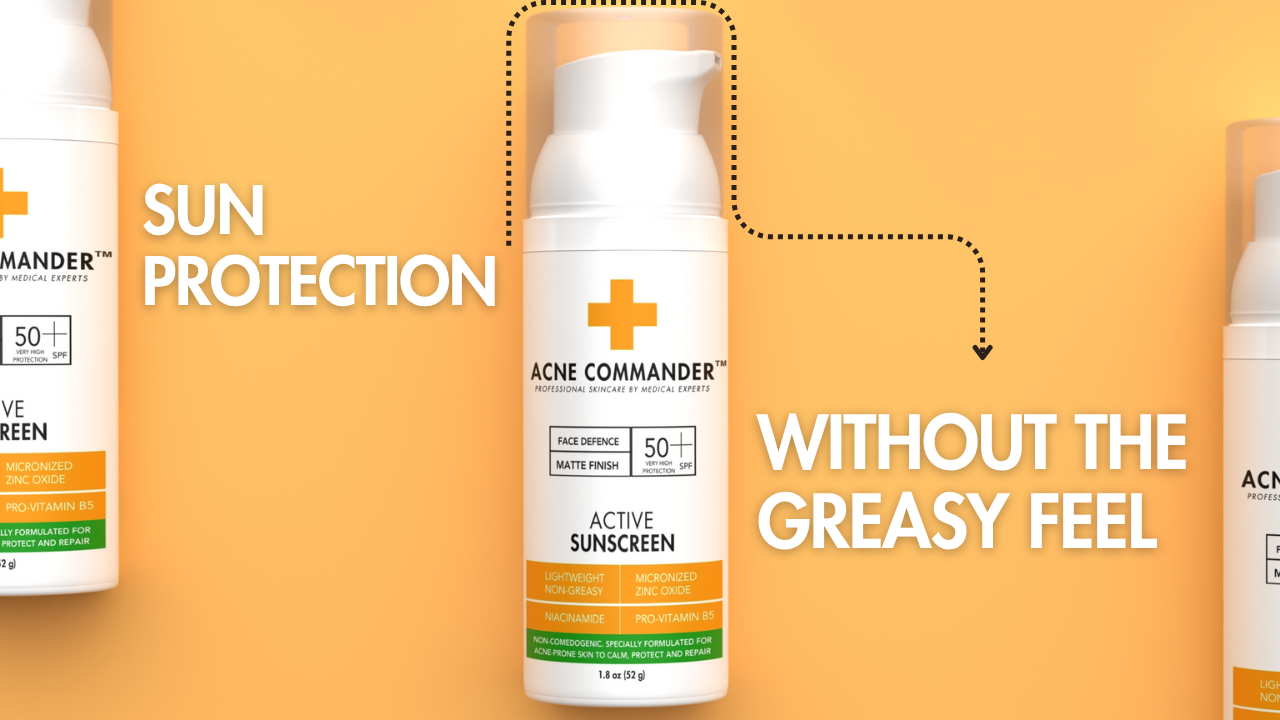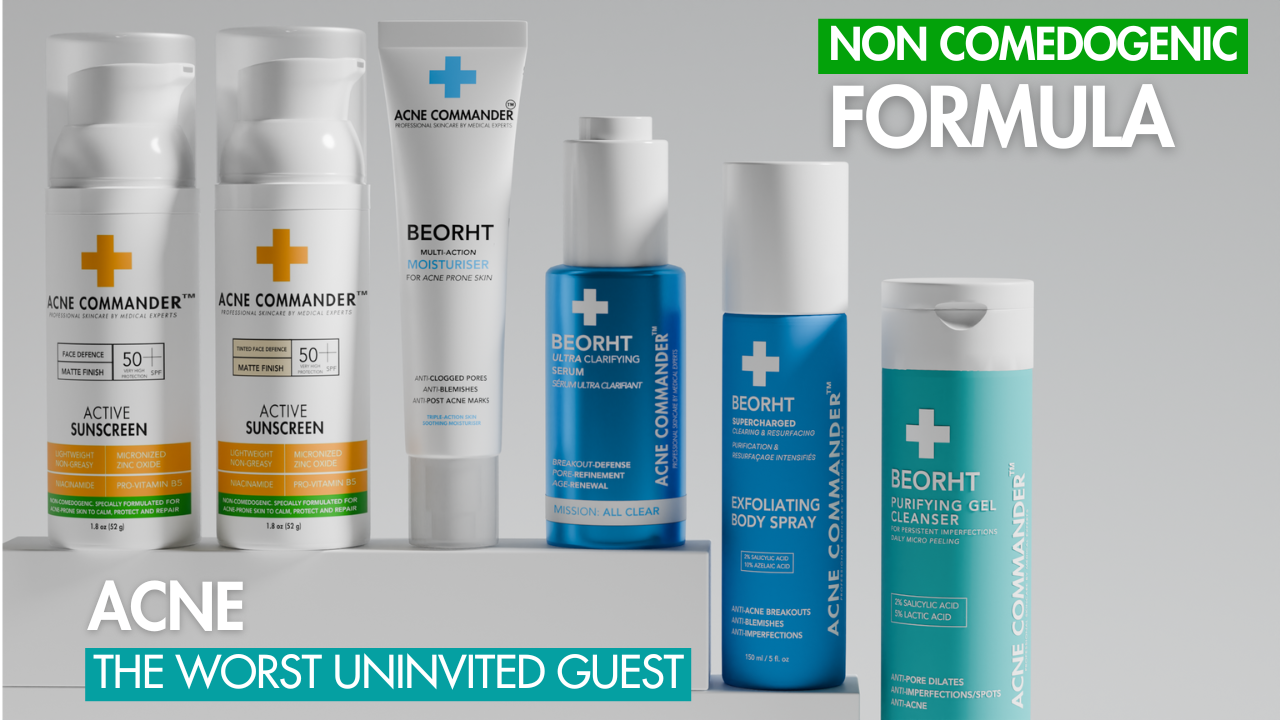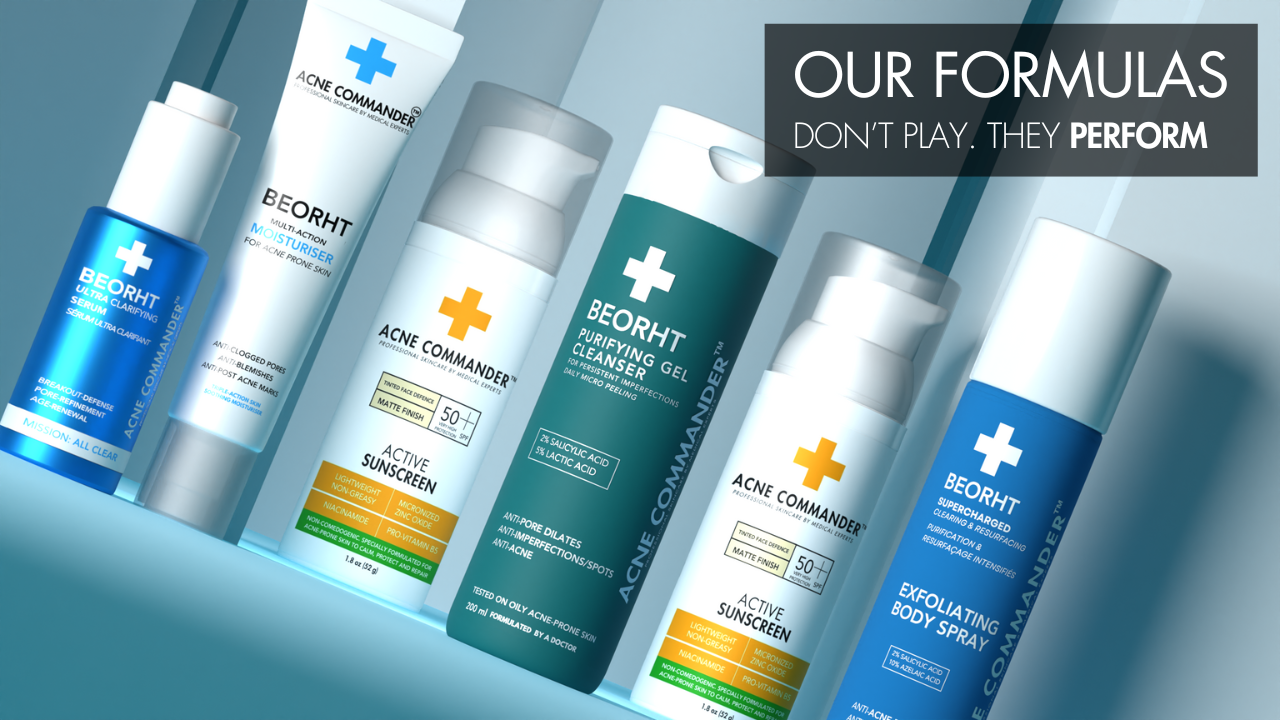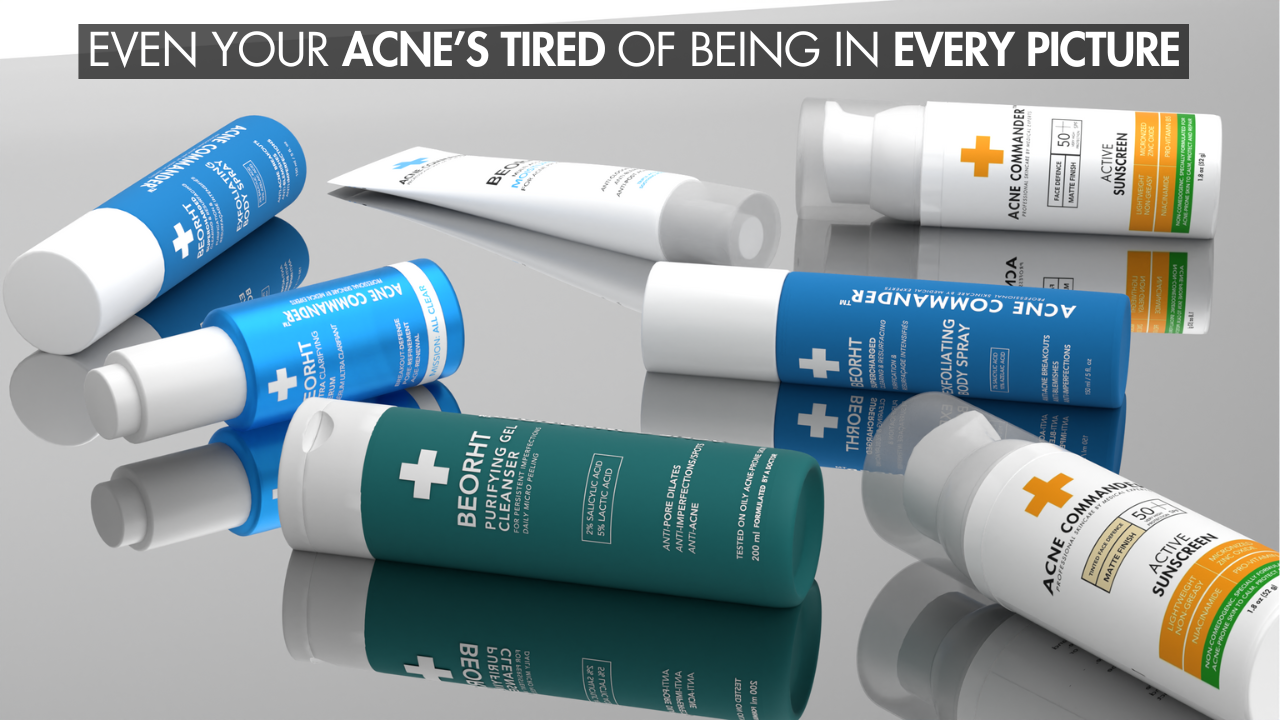Introduction
Salicylic Acid is one of the most commonly used ingredients in acne treatments, praised for its ability to target the root causes of acne. As a beta hydroxy acid (BHA), Salicylic Acid offers a variety of benefits for acne-prone skin, from clearing clogged pores to reducing inflammation and preventing new breakouts. But how does Salicylic Acid help treat acne-prone skin?
In this article, we’ll dive into the science behind Salicylic Acid, explore its benefits for acne-prone skin, and explain how it works to treat and prevent acne. We’ll also highlight how products like Acne Commander’s Beorht Purifying Gel Cleanser, which contains Salicylic Acid, can be an effective part of your acne-fighting skincare routine.
What Is Salicylic Acid?
Salicylic Acid is a type of beta hydroxy acid (BHA) that is derived from willow bark. It’s a chemical exfoliant, meaning it works to remove dead skin cells from the surface of the skin and help clear clogged pores. Unlike alpha hydroxy acids (AHAs) like Glycolic Acid, Salicylic Acid is oil-soluble, which gives it the unique ability to penetrate deep into the pores to exfoliate from within.
Salicylic Acid is often used in acne treatments because it directly addresses the key causes of acne, such as clogged pores, excess oil production, and inflammation. It’s a staple in many over-the-counter acne treatments due to its effectiveness and mild nature compared to other acne-fighting ingredients like Benzoyl Peroxide.
How Does Salicylic Acid Help Treat Acne?
1. Exfoliates the Skin
Salicylic Acid works by exfoliating the skin to remove dead skin cells that can clog pores. Clogged pores are one of the primary causes of acne, as they trap oil, dead skin cells, and bacteria, leading to inflammation and breakouts.
As an exfoliant, Salicylic Acid helps to slough off these dead skin cells, promoting a smoother complexion and allowing pores to remain open and clear. By preventing clogged pores, Salicylic Acid helps reduce the frequency of breakouts.
2. Penetrates Deep Into Pores
Salicylic Acid is oil-soluble, which means it can penetrate deep into the pores, unlike water-soluble ingredients. This is particularly helpful for acne-prone skin, as it allows Salicylic Acid to work directly where acne starts in the pores.
By entering the pores, Salicylic Acid dissolves the excess oil and dead skin cells that may be contributing to clogged pores. This ability to target the root cause of acne helps Salicylic Acid treat both existing breakouts and prevent future ones from forming.
3. Reduces Inflammation
Acne is often associated with inflammation, which leads to redness, swelling, and the painful cysts or pimples associated with more severe forms of acne. Salicylic Acid has anti-inflammatory properties that help reduce the swelling and redness associated with acne.
Salicylic Acid also helps calm the skin by promoting the shedding of dead skin cells, which prevents the buildup of debris that can cause irritation. This makes it a great ingredient for inflamed acne, such as cystic acne or pustules.
4. Controls Excess Oil Production
Excess oil production is a major contributor to acne, as it mixes with dead skin cells to form blockages in the pores. Salicylic Acid helps regulate oil production by removing the excess oil on the surface of the skin and preventing oil from accumulating in the pores.
By controlling oil production, Salicylic Acid helps to balance the skin and prevent the oily buildup that can contribute to acne formation. This is particularly beneficial for those with oily or combination skin types who are prone to frequent breakouts.
Benefits of Salicylic Acid for Acne-Prone Skin
Salicylic Acid offers a range of benefits for acne-prone skin, making it a go-to ingredient in many acne treatment products. Here are the key benefits of incorporating Salicylic Acid into your acne skincare routine:
1. Prevents Clogged Pores
Salicylic Acid works by exfoliating the skin and removing dead skin cells, which helps to keep the pores clear and free from blockages. Preventing clogged pores is essential for preventing acne, as clogged pores trap oil and bacteria, leading to breakouts.
2. Reduces Blackheads and Whiteheads
Blackheads and whiteheads are types of non-inflammatory acne that form when pores become clogged with oil and dead skin cells. Salicylic Acid is highly effective at treating blackheads and whiteheads because it can penetrate the pores and dissolve the oil and dead skin cells causing the blockages.
3. Minimizes Acne Scarring
While Salicylic Acid primarily works to treat active acne, it can also help fade acne scars over time. By promoting cell turnover and encouraging the shedding of damaged skin cells, Salicylic Acid helps to lighten dark spots and improve the overall texture of the skin.
4. Prevents New Breakouts
Salicylic Acid helps prevent new breakouts by keeping the pores clear of excess oil and dead skin cells. This is important because acne often recurs when the skin is not properly exfoliated, leading to clogged pores. By preventing these blockages, Salicylic Acid helps keep the skin clear and free from future breakouts.
5. Gentle on the Skin
Salicylic Acid is generally considered gentler than other acne treatments like Benzoyl Peroxide, making it suitable for a variety of skin types, including sensitive skin. It works by targeting the underlying causes of acne without causing excessive dryness or irritation. However, it’s still important to use Salicylic Acid in moderation, as overuse can lead to dryness.
How to Use Salicylic Acid for Acne
To get the most out of Salicylic Acid, it’s important to use it properly in your skincare routine. Here’s how to incorporate Salicylic Acid into your daily routine:
1. Cleanse Your Skin First
Start by cleansing your face with a gentle cleanser to remove dirt, oil, and impurities. Use a gentle, acne-safe cleanser that will prepare your skin to better absorb Salicylic Acid without stripping it of its natural oils.
2. Apply Salicylic Acid
After cleansing, apply a Salicylic Acid treatment or Salicylic Acid-based cleanser directly to your face. If you’re using a cleanser with Salicylic Acid, apply it to damp skin, gently massage for 30-60 seconds, and rinse thoroughly with lukewarm water. If you’re using a leave-on treatment, apply it to your skin and leave it on overnight or as directed.
3. Moisturize
After applying Salicylic Acid, always follow up with a non-comedogenic moisturizer to prevent the skin from drying out. Salicylic Acid can be drying, so moisturizing helps to maintain your skin’s moisture balance and prevent irritation.
4. Start Slowly
If you’ve never used Salicylic Acid before, start by incorporating it into your routine gradually. Begin by using it 2-3 times a week and gradually increase the frequency as your skin builds tolerance. This will help prevent irritation and dryness.
5. Wear Sunscreen
Salicylic Acid can make your skin more sensitive to the sun, so it’s important to wear sunscreen during the day to protect your skin from harmful UV rays. Sunscreen helps prevent pigmentation and skin damage, especially when using exfoliating products like Salicylic Acid.
Beorht Purifying Gel Cleanser: A Great Option for Acne-Prone Skin
If you're looking for a product that combines the benefits of Salicylic Acid with other soothing and hydrating ingredients, Acne Commander’s Beorht Purifying Gel Cleanser is an excellent choice. Here’s why it works so well for acne-prone skin:
Salicylic Acid 2%: Salicylic Acid penetrates deep into the pores to break down excess oil and dead skin cells, preventing acne and helping to clear existing breakouts.
Lactic Acid 5%: Lactic Acid gently exfoliates the skin’s surface, improving texture and helping to fade acne scars over time.
Non-Comedogenic Formula: Beorht Purifying Gel Cleanser is designed to be non-comedogenic, so it won’t clog pores or contribute to acne.
Soothing Plant Extracts: Scutellaria Baicalensis Root Extract and Sophora Angustifolia Root Extract reduce inflammation and calm irritated skin, which is common with acne.
Hydrating Ingredients: Sodium PCA and Butylene Glycol help keep the skin hydrated, preventing dryness and irritation.
Beorht Purifying Gel Cleanser combines Salicylic Acid with Lactic Acid and other soothing ingredients to treat acne and improve skin texture without drying out the skin.
Explore detailed information for Acne Commander's Beorht Purifying Gel Cleanser. Click Here
FAQ
Q1: How does Salicylic Acid help with acne?
Salicylic Acid exfoliates the skin by removing dead skin cells, penetrates deep into the pores to break down oil, and reduces inflammation. This helps prevent clogged pores, breakouts, and acne scars.
Q2: Can I use Salicylic Acid if I have sensitive skin?
Yes, Salicylic Acid is generally gentler than Benzoyl Peroxide, making it suitable for sensitive skin. However, start with lower concentrations and gradually increase use to avoid irritation.
Q3: How often should I use Salicylic Acid for acne?
Begin by using Salicylic Acid 2-3 times a week and gradually increase to daily use as your skin builds tolerance. Always follow with a moisturizer to prevent dryness.
Q4: Does Salicylic Acid work for cystic acne?
Yes, Salicylic Acid can help treat inflammatory acne like cystic acne by reducing inflammation, unclogging pores, and preventing future breakouts.
Q5: Can I use Salicylic Acid with other acne treatments?
Yes, you can use Salicylic Acid with other acne treatments like Benzoyl Peroxide or Retinol, but be cautious not to over-exfoliate or irritate the skin.
Q6: How long does it take for Salicylic Acid to work?
You may start seeing results in 2-3 weeks, but it can take up to 6 weeks for full results. Consistency is key for effective acne treatment.
Q7: Can Salicylic Acid cause dryness?
Yes, Salicylic Acid can dry out the skin, especially in higher concentrations. Always follow with a non-comedogenic moisturizer to keep your skin hydrated.
Q8: Does Beorht Purifying Gel Cleanser help with acne scars?
Yes, Lactic Acid in Beorht Purifying Gel Cleanser helps exfoliate the skin, improve texture, and fade acne scars over time.
Q9: Is Salicylic Acid safe for long-term use?
Yes, Salicylic Acid is safe for long-term use when applied correctly. It helps maintain clear skin by preventing clogged pores and breakouts.
Q10: Can I use Salicylic Acid during pregnancy?
Consult with a healthcare professional before using Salicylic Acid during pregnancy, as high concentrations may not be recommended.
Conclusion
Salicylic Acid is one of the most effective ingredients for treating acne-prone skin. By exfoliating, clearing clogged pores, and reducing inflammation, Salicylic Acid helps prevent new breakouts and improves overall skin texture. Acne Commander’s Beorht Purifying Gel Cleanser offers a great solution for acne-prone skin, combining Salicylic Acid with Lactic Acid and other soothing ingredients to treat acne and promote clearer, healthier skin.
Call to Action: Ready to fight acne and achieve clearer skin? Try Acne Commander’s Beorht Purifying Gel Cleanser today and experience the benefits of Salicylic Acid for acne!






